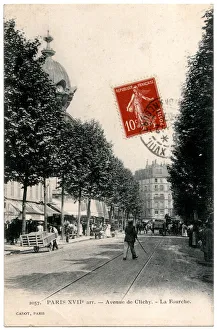Fourche Collection
"Exploring the Versatile World of 'Fourche': From Pitchforks to Engravings" In the realm of Le Vocabulaire Illustre
All Professionally Made to Order for Quick Shipping
"Exploring the Versatile World of 'Fourche': From Pitchforks to Engravings" In the realm of Le Vocabulaire Illustre, the word "fourche" takes us on a journey through various intriguing contexts. Starting with its literal meaning as a pitchfork, we envision farmers tending to their fields and hay bales neatly stacked in rustic barns. The Heugabel engraving further immerses us in this agricultural scene, capturing the essence of rural life. Shifting our focus to La Fourche, Avenue de Clichy in Paris, France, we find ourselves amidst bustling city streets. This vibrant location holds historical significance and cultural charm that captivates both locals and tourists alike. As we stroll along this avenue, memories from different eras flood our minds. Transporting back to 1814 through illustrations from A French Alphabet Book, we witness how fourches were depicted during that time period. These engravings provide glimpses into daily life and offer insights into how tools like pitchforks were utilized by people of yesteryears. Moving forward to 1905 on Avenue de St Ouen in Paris, another facet of 'fourche' emerges – an artistic expression captured by photographers who immortalize moments frozen in time. The black-and-white photographs evoke nostalgia while showcasing the ever-evolving nature of Parisian society. Delving deeper into history's tapestry reveals unexpected connections between 'fourche' and significant events such as General de Bourmont's conquest of Algiers in July 1830 or the Third Status Etrennes to Clerge. These instances highlight how even seemingly mundane objects can be entwined with pivotal moments shaping nations and societies. Finally, let us not forget about the remarkable women who played diverse roles throughout history – from fishmongers known as "Parisian poisarden" to influential figures participating in events like October 5th, 1789.









